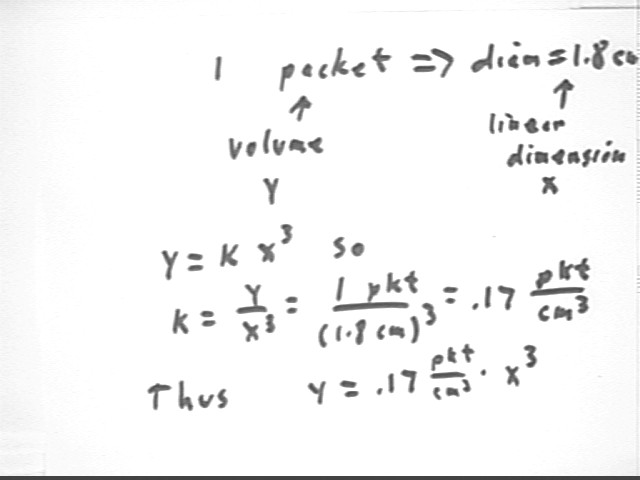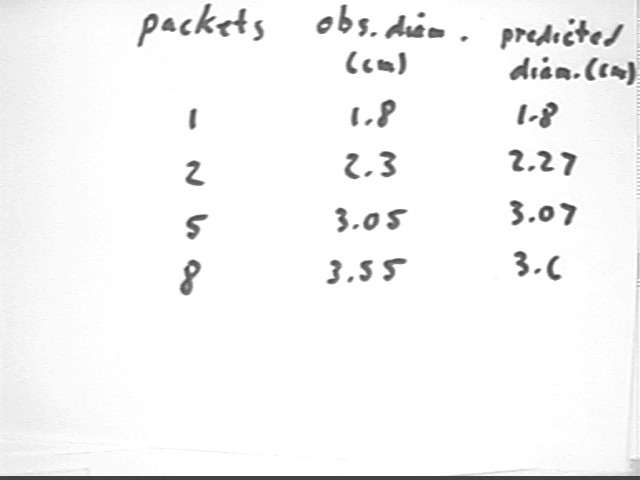
Calculus I Quiz 0923
Problem: At what average rate does the exponential principle function P(t) = 24 * 1.2 ^ t change between clock times 2.7 and 2.701?
Problem: If it takes 4 million level tablespoons of sand to build a sandpile 9 meters in diameter, then what function gives the number of tablespoons of sand required to build a geometrically similar sandpile as a function of diameter in meters?
We use the proportionality of volumes to linear dimensions, which is volume = k * diameter^3. We evaluate k using the given information:
k = volume / diameter^3 = 4 million tablespoons / (9 meters)^3 = .0055 million tablespoons / meter^3. Thus
volume = .0055 million tbsp / m^3 * diameter^3.
We could plug in 9.0001 meters to get the result. Or we could use y for volume and x for diameter and write (understanding the implicit units)
y = .0055 x^3.
Then the rate at which y changes with respect to x is given by the derivative
y ' = .0055 ( 3 x^2) = .0165 x^2.
Evaluating this derivative for the given sandpile we get
y ' = .0165 * 9^2 = 1.34,
with units of k * units of x^2, or (million tbsp / m^3 ) * m^2 = million tbsp / meter.
We use this to find the approximate change y ' * `dx in volume from x = 9 m to x = 9.0001 m. We get
`dy = y ' * `dx = 1.34 million tbsp / meter * .0001 meter = .000134 million tbsp = 134 tbsp.
We can check this by evalating y(9.0001) - y(9.0000) for y(x) = y = .0055 x^3.
We get 0.0001336514896 million tbsp or about 134 tbsp.
Thus the direct calculation justifies the differential approximation.
Average rate is (4.000134 - 4.00000) / .0001 = 1.34, confirming the above.
Salt packets.
1 salt packet poured out yields a salt cone of diameter 1.8 cm.
Question: What will be the diameter if we pour out two salt packets, carefully forming another circular cone?
By the Theory of Neo-Bio-Cubism, which states that whales are made up of little whalecubes that scale up proportionally as the dimensions of the whale change with growth, we know that for geometrically similar objects volume is proportional to the cube of linear dimensions. Again, according to the Theroy, this is because everything is made up of tiny cubes and this is the way cubes grow.
So we know that for salt piles, assuming geometric similarity,
If volume is 1 packet and diameter is 1.8 cm then we have
Thus volume = .17 packet/cm^3 * diameter^3.

If volume = 2 packets, then we have
= (2 packets / (.17 packet / cm^3) ) ^ (1/3) =
2.27 cm.
Pouring out another packet we observe diameter 2.3 cm. This appears to be pretty good confirmation for the Theory of Neo-Bio-Cubism.
Continuing to pour out packets of salt we observe a diameter of 3.05 cm for a 5-packet cone and 3.55 cm for an 8-packet cone, almost exactly confirming our Theory.

Solve using ratios instead of functional proportionalities:
Calories are proportional to quantity of ice cream, which fills volumes. Therefore calories are proportional to the cube of linear dimension. If we let y = calories and x = height, therefore, we have y = k x^3.
If y = k x^3 then (y2 / y1) = (k x2^3 / (k x1^3)) = (x2 / x1)^3.
From the ratio relationship (y2 / y1) = (x2 / x1)^3 we easily get y2 = y1 ( x2 / x1 )^3.
Here we're given x1 = 3.5 and x2 = 7, with y1 = 78, approx.. So we have
y2 = y1 ( x2 / x1)^3 = 78 ( 7 / 3.5)^3 = 78 cal * 8 = 624 cal.
Melting is from the surface and the proportionality is y = k x^2, where y is melting rate and x is linear dimension. An analysis similar to the above tells us that
y2 = y1 ( x2/x1)^2,
from which we get
y2 = 48.7 ( 7 / 3.5)^2 = 48.7 * 4 = 194.8, meaning 194.8 grams / minute.
Problem: Write the differential equation expressing the statement that the rate which the temperature T changes with respect to time t is proportional to the difference between the temperature T and the 27 degree room temperature.
The rate of change of T with respect to t is dT / dt or T '. The difference between temperature and room temperature is (T - 27).
So the proportionality is
dT / dt = k ( T - 27), or alternatively
T ' = k ( T - 27).